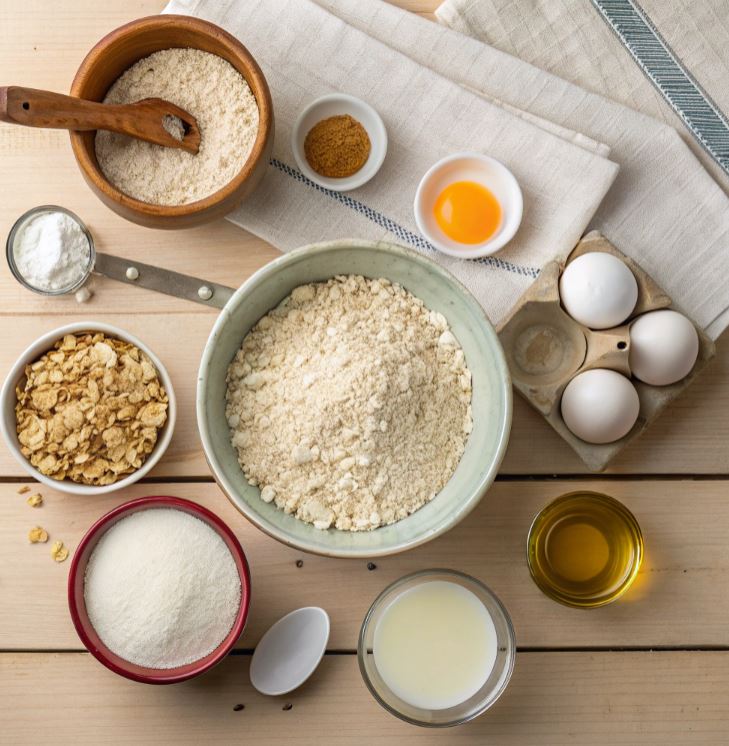Oat flour pancakes offer a nutritious and delicious alternative to traditional pancakes. Made from finely ground oats, these pancakes provide a hearty texture while being naturally gluten-free. Many home cooks appreciate them for their wholesome ingredients and ease of preparation. Whether you are looking for a healthier breakfast option or simply enjoy the mild, nutty flavor of oats, oat flour pancakes make a fantastic choice.

Unlike conventional pancakes made with refined flour, oat flour pancakes have a higher fiber content, which promotes digestion and keeps you full longer. They pair well with various toppings, including fresh fruit, honey, or nut butter, making them versatile and satisfying. This article explores their history, global variations, ingredients, preparation methods, and health benefits to provide you with all the information needed to master the perfect batch at home.
History and Origins of Oat Flour Pancakes
Pancakes have been a staple in many cultures for centuries, and the use of oat flour pancakes is an extension of this longstanding tradition. Historically, oats have been cultivated in regions with cooler climates, such as Scotland and Northern Europe, where wheat was less abundant. Oats quickly became a primary grain for many populations, leading to the creation of various oat-based recipes, including pancakes.
In Scotland, oatcakes were a dietary staple for centuries. These were often prepared with simple ingredients such as water and salt, then cooked over an open flame. Over time, as dietary preferences evolved, oatcakes transformed into softer, more flavorful oat flour pancakes. Today, these pancakes are enjoyed worldwide, adapting to regional flavors and dietary needs. Their naturally hearty texture and nutritional benefits make them a popular choice among health-conscious individuals.
This Recipe All Over the World
The versatility of oat flour pancakes has led to their adoption in different parts of the world, each culture adding its unique spin. While they originate from oat-eating regions, their appeal has spread globally, with variations that reflect local ingredients and culinary traditions.
- United States: Often served with maple syrup and fresh berries, these pancakes have become a popular breakfast choice for those looking to add more whole grains to their diet.
- Scotland: The traditional oatcakes have transformed into softer oat flour pancakes, sometimes paired with savory toppings like smoked salmon.
- India: Variations of oat-based pancakes incorporate spices such as turmeric and cumin, offering a more savory approach.
- Nordic Countries: Here, oat flour pancakes may be thinner and served with lingonberry jam or yogurt.
No matter where they are made, oat flour pancakes continue to be a nutritious and adaptable dish, fitting various dietary preferences.
Detailed Ingredients for Oat Flour Pancakes
To create fluffy and flavorful oat flour pancakes, selecting the right ingredients is essential. Each component plays a role in ensuring the best texture and taste.
Essential Ingredients:

- Oat flour – Provides a hearty texture and natural sweetness.
- Eggs – Acts as a binding agent and adds moisture.
- Milk (dairy or plant-based) – Helps create a smooth, pourable batter.
- Baking powder – Ensures the pancakes rise and remain fluffy.
- Salt – Enhances the flavor by balancing sweetness.
- Vanilla extract – Adds depth and warmth to the taste.
- Sweetener (honey, maple syrup, or coconut sugar) – Brings out the natural flavors of oats.
Optional Additions:
- Cinnamon or nutmeg – Introduces warm, aromatic notes.
- Chia seeds or flaxseeds – Boosts fiber and omega-3 content.
- Mashed banana or applesauce – Adds natural sweetness and moisture.
Step-by-Step Instructions
Making oat flour pancakes is a simple and rewarding process. Follow these steps for a perfect batch every time:
- Prepare the oat flour: If using whole oats, blend them into a fine powder using a food processor.
- Mix the dry ingredients: In a bowl, combine oat flour, baking powder, salt, and any spices.
- Whisk the wet ingredients: In a separate bowl, beat the eggs, milk, vanilla extract, and sweetener.
- Combine wet and dry mixtures: Gradually add the wet ingredients to the dry, stirring gently until smooth.
- Rest the batter: Allow it to sit for 5-10 minutes to thicken.
- Preheat the pan: Heat a non-stick skillet over medium heat and lightly grease it.
- Cook the pancakes: Pour batter onto the pan and cook for 2-3 minutes until bubbles form, then flip and cook for another 2 minutes.
- Serve warm: Top with fresh fruit, yogurt, or maple syrup.
Tips for Perfect Oat Flour Pancakes
- Use freshly ground oat flour for the best texture.
- Let the batter rest to allow the oat flour to absorb the liquid.
- Avoid overmixing to prevent dense pancakes.
- Cook on medium heat to ensure even browning without burning.
- Experiment with toppings like nuts, seeds, or flavored syrups.
Health Benefits of Oat Flour Pancakes
Oat flour pancakes offer a range of health benefits, making them an excellent addition to any diet.
- Rich in fiber – Supports digestion and keeps you full longer.
- Naturally gluten-free – Ideal for those with gluten sensitivities.
- Provides essential nutrients – Contains vitamins and minerals like iron and magnesium.
- Balances blood sugar levels – Oats have a lower glycemic index than refined flour.
- Supports heart health – Oats contain beta-glucan, known for its cholesterol-lowering effects.
Diet Information
Depending on the ingredients used, oat flour pancakes can fit various dietary preferences:
- Gluten-Free: Ensure oats are certified gluten-free.
- Dairy-Free: Use almond, coconut, or oat milk as substitutes.
- Vegan: Replace eggs with mashed bananas or flaxseed eggs.
- Low-Sugar: Use natural sweeteners like monk fruit or skip added sugar.
By adjusting the recipe to suit specific needs, oat flour pancakes can be enjoyed by a wide range of individuals looking for a healthy, satisfying meal.
